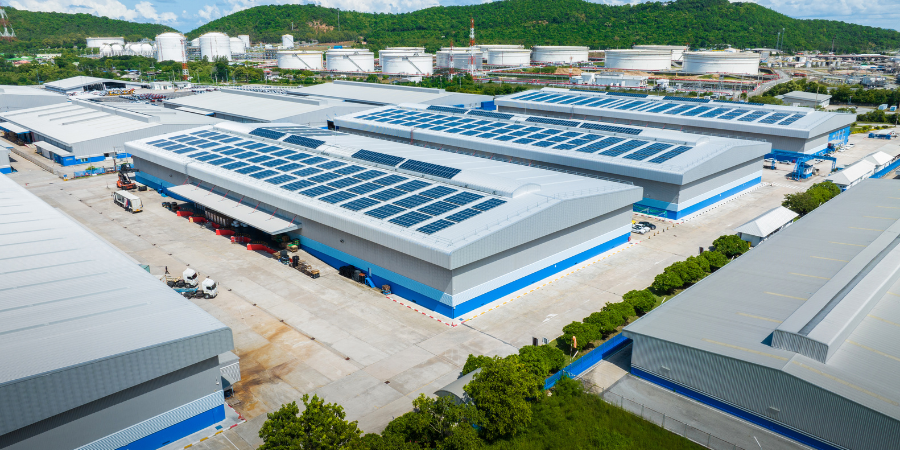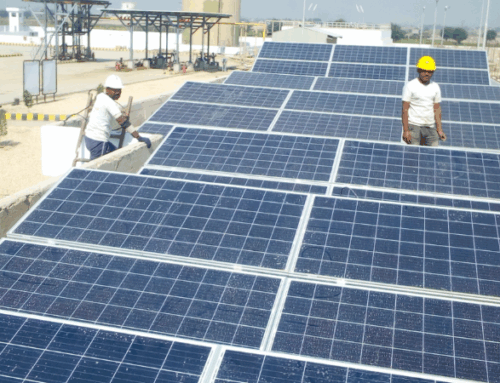The energy transition away from fossil fuel electricity generation towards sustainable energy sources is becoming increasingly vital in our journey to combating climate change. Within this green revolution, commercial solar energy emerges at the helm, offering businesses an opportunity to not only support the environment, but to also benefit financially. This article aims to explore the multifaceted world of commercial solar energy, delving into the technology of commercial solar, its applications, and the various financial incentives available for commercial solar systems. If you own or operate a commercial or industrial organization and are looking for ways to reduce energy costs for your business, uncover the benefits of solar energy for your operation.
What Is Commercial Solar Energy?
Commercial solar energy, also known as photovoltaic (PV) energy, utilizes solar panels and systems to generate electricity for commercial, industrial, or municipal applications. Commercial solar systems are specifically designed based on a business’s energy consumption and/or available space to install PV panels. While some businesses might have rooftops with much sun exposure, others could be limited and it may not be profitable to install solar panels on the entire roof. Some commercial solar applications utilize parking lot space through the construction of parking canopies, while others try to utilize extra land that they might own at or near their business.
Commercial Solar vs. Residential Solar
Commercial solar and residential solar vary quite differently. While homeowners purchasing residential solar applications are looking to offset their home’s energy usage, business owners are often attempting to offset much more energy consumption. Because commercial energy consumption is drastically higher than residential energy usage, it is important for a business owner to calculate his business energy consumption prior to looking at a solar project. Oftentimes, the solar arrays will not be able to produce enough energy to offset 100% of the business energy consumption. This is an important factor to consider when evaluating your commercial solar options. The average residential solar system produces 10,000 watts of electricity, while commercial solar systems can be millions of watts of power. This causes the costs of commercial solar to outweigh residential solar and make the projects more difficult to finance and engineer.
Is Commercial Solar Profitable?
The answer: it depends. The profitability of a commercial solar system depends on several factors. And, many times these factors are predicated on the location of the system due to state-specific incentives. When looking at the numbers, it is important to be aware of the costs, benefits, and financial perks associated with commercial PV. The best way to do this is to transform your solar project into a financial statement with income, expenses, assets, and liabilities. Let’s explore this in more detail in the example below.
For this illustration, we will assume the following:
- the size of the commercial solar system is 500 kW, or 500,000 watts
- the purchase price is $3.50 per watt
- the customer’s local utility rates are $0.20/kWh
- The 500 kW system will produce 600,000 kWh annually
- The location of the project is in NJ where SRECS are valued at $40
- 1,000 kWh of solar project equates to a single SREC
- Annual maintenance costs are $4,000
- Standard depreciation rate of 3.6% for 27 years
| Solar System Purchase Price | $1,750,000 |
| 30% Federal Tax Credit | ($525,000) |
| Cost After Tax Credit | $1,225,000 |
| INCOME | |
| SREC Income | $24,000 |
| Energy Savings | $120,000 |
| TOTAL ANNUAL INCOME | $144,000 |
| EXPENSES | |
| Maintenance | $4,000 |
| Depreciation | $63,000 |
| TOTAL ANNUAL EXPENSES | $67,000 |
| NET Annual Income | $77,000 |
Now, there are several ways to look at the profitability or return on investment with this example. One school of thought says that the business is earning $77,000 per year on a $1,225,000 investment (purchase price after tax credit). This gives the business owner a 6.2% annual rate of return.
Another school of thought is to take the annual benefit from the SREC income and energy savings, less maintenance costs ($140,000) and divide it into the total system cost after the tax credit ($1,225,000). In this scenario, the business owner recoups his investment in 8.75 years and then gets free power from the solar system (less any maintenance costs).
Another scenario, that we will discuss in more detail below, is bonus depreciation. The IRS allows businesses to depreciate 100% of the solar project cost in year one. This allows the owner to offset all of the income generated by the system as well as other business income he might have in that year. Remember, depreciation is not a one-to-one benefit as the total cash value is based on your tax rate.
In each scenario, this appears to be a profitable deal for the business owner. Now, remember, the SREC inventive income is a state-based incentive and will change based on the project’s location. It’s best to evaluate each commercial solar project on an individual basis to determine its profitability.
Best Solar Systems For Commercial Use
There are several ways to construct a commercial solar system. While most private businesses are concerned with the financial aspects of the solar project, other organizations are more driven by environmental benefits. All of these factors play a role in determining how much solar to install on a property. Let’s explore some of the more uses of commercial solar below and their advantages.
Rooftop Solar System
A rooftop solar system consists of photovoltaic (PV) panels installed on the roof of a building to convert sunlight into electricity. This setup is designed to seamlessly integrate on the building’s roof and electrical system, making it the most popular commercial solar system use. If the business’s roof has a lot of sun exposure, this is often the very best and most affordable way to install solar.
Carport Solar System
A carport system is another type of solar system for commercial use. This design involves the construction of carport canopies in a business’s parking lot. The carport is designed in such a way that cars can park underneath while solar arrays are mounted on top of the structure. This is often implemented when the building’s roof cannot get enough sunlight or hold enough solar panels. While carport solar systems are a great way to produce more electricity, they can be costly to construct and often affect the profitability of the solar project.
Ground Mount Solar System
A ground mount system involves installing ground-mounted steel and/or other structures that can support the installation of solar panels in an open area, such as a field. Like the carport systems, ground-mounted solar systems can be more costly to install when compared to rooftop systems, as the cost of steel and construction can outweigh the benefits from the energy production. However, businesses that have limited rooftop space or lots of open land often take advantage of this commercial solar installation option.
Who Is Eligible For Commercial Solar?
While most businesses in all states are eligible for commercial solar, individual state incentives play a role in determining the profitability of each project. For example, in Pennsylvania, solar renewable energy credits (SRECS) are not fixed in value. So when a Pennsylvania-based business installs solar panels, they have to project the future value of their SRECS to forecast the project’s ROI. In New Jersey, however, SRECS values are fixed. This allows NJ businesses to have more certainty when it comes to their investment in solar.
Other factors also play a role in determining a business’s solar eligibility. For example, in some states, there is limited solar capacity based on the location of the solar system. Because the electricity grid is not designed to be able to handle an unlimited influx of solar energy production, electric grid operators limit the total amount of solar that can be installed at specific locations on the electric transmission lines. Another factor has to do with sun exposure. If your business is located in a very shady area, they may need to consider cutting down trees in order to allow solar panels to produce the desired amount of electricity. This can be a challenge in some areas or with certain landlords.
The Benefits Of Commercial Solar Energy Systems
The adoption of commercial solar energy systems offers a myriad of benefits that extend beyond environmental effects to include substantial economic and operational advantages. Below, we highlight the key benefits that businesses can leverage by integrating solar power into their operations.
- Reduced business energy expenses based on solar system production
- 30% federal investment tax credit based on total system cost
- Solar renewable energy credit (SREC) income paid by utility companies
- Bonus depreciation allowed by the IRS
- Increased public image of brand through a commitment to clean energy
- Positive environmental impacts promoting sustainable energy
- Energy security with on-site electricity generation
- Energy independence and less reliance on the electric grid
- Energy production during peak hours to offset electricity costs
- Low maintenance costs
- Long term energy production as most systems have 40+ year life spans
- Increased property value and business value
- Support for local solar and electrical contractors
The Challenges Of Commercial Solar
While installing a commercial solar system has many benefits, it also comes with some challenges. Let’s explore some of the top challenges faced by our customers today when considering a solar option.
- High cost of installation
- Sometimes can be hard to secure financing for large projects
- Interests rates are high and eat into project profitability
- Unsecure financial incentives in certain states that have the potential to go away
- Inability to get project approved by utility due to over saturation in a specific area of the electric grid
- Lack of sun exposure at your business or facility
- High construction costs if located in union-controlled area
- Complex solar legal agreements and contracts
- Roof replacement costs if roof is dated
- Liability for damage during solar system installation. Who is responsible?
- Complex permitting process in certain jurisdictions
How Commercial Customers Can Get Started With Solar
If you are thinking about a solar system at your business, the best place to start is with a free solar consultation. During this stage, a solar expert will evaluate your building, your roof, its sun exposure, local rules and regulations, available solar incentives, your building’s energy production, and more. At this step of the process, you can even design a solar system virtually to see how it will look on your building and to project its energy performance. This will give you a good idea of the potential of solar at your business and whether it’s worth taking the next step.
Thinking About Exploring Solar?
At Diversegy, our team of energy experts has a deep understanding of the solar energy industry and how to engineer commercial solar systems for our customers. In fact, through our parent company, we are part of a conglomerate of energy companies that manufacturers, engineers, and installs solar panels for commercial businesses. Want a free quote to see how solar might work for your business or organization? Contact our team today!



